7 Ways to Use Templates for Review Responses

Collecting and displaying reviews is proven to drive some pretty impressive results for your business. According to an analysis from our friends at Bazaarvoice, there’s a 128% lift in conversion when shoppers interact with ratings and reviews on “best-in-class” sites — as well as a 159% lift in revenue per visitor.
But responding to reviews is an equally important part of a comprehensive review strategy.
When you respond to a negative review, you have the opportunity to turn a bad situation around and win back the trust of an unhappy customer. According to Salesforce’s research, 78% of consumers will forgive a company for a mistake after receiving excellent service. Plus, a response to a negative review signals to future customers that you’re a brand that supports its customers. This is important, as BrightLocal research found that among those who read reviews, 96% also read businesses’ responses to reviews at least occasionally. And 40% always do so.
On the other hand, responding to a positive review can help you forge stronger relationships with your happy customers — which can lead to future purchases and greater lifetime value. Research from Motista found that consumers who feel emotionally connected to brands have 306% greater lifetime value and stick with the brand 1.5 times longer than those who don’t feel that way.
Responding to Reviews Isn’t Always Easy — But Review Response Templates Ease the Burden
It’s certainly important to respond to reviews. But the reality is, it can be time-consuming. This is especially true if you have reviews coming in for your products, locations, mobile apps, and other aspects of your business.
To further complicate matters, you probably have more than one person responsible for responding to reviews. It can be tough to ensure all responses are on-brand — regardless of who actually wrote them.
The good news is, review response templates can save you time and ensure your responses always reflect your unique brand voice.
Read on to explore what review response templates are, how to use them, and when to use them.
What are Review Response Templates?
Templates for review responses are pre-written, approved, and on-brand responses customer service agents can use when responding to reviews. These templates can be housed in a variety of locations. Some organizations save them in a document on a shared drive. Or, if you’re a Reputation Studio customer, you can house the templates within the solution for easy access.
It’s important to remember that review response templates aren’t meant to be copied and pasted as-is. If you post the exact same response to all of your reviews, you’ll come across as inauthentic and robotic!
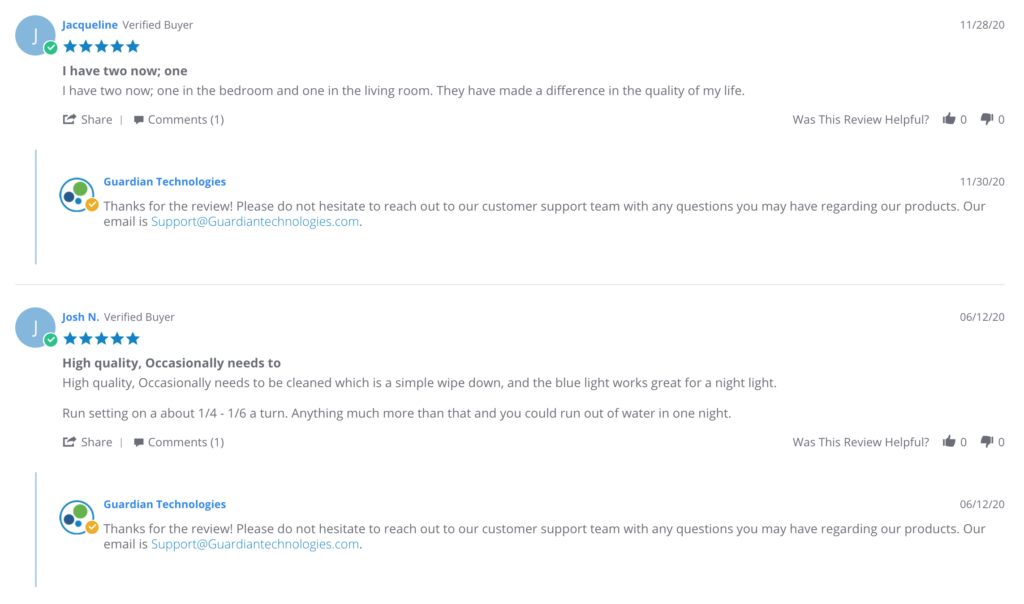
While review response templates are useful, they should always be tailored to each customer’s unique concern. Simply reiterating your email or phone number is not always useful, as a customer could have found that from your website.
Rather, templates serve as a great starting point so agents don’t have to start from scratch every time a review comes in that requires a response. Instead, agents can choose a template that best matches the situation — and then customize it to fit the individual review.
7 Instances When You Should Use a Review Response Template
So when does it make sense to start with a template? Here are 7 common scenarios that are great use cases for review response templates.
1. When you get a star-only rating with no accompanying review.
Some websites — including Amazon and Walmart — allow shoppers to submit a star rating without an accompanying written review. Consider creating two different templates to use for star-only ratings.
One template can be used when responding to positive star ratings (four and five stars) — such as this one for a children’s toy. The template can include language to thank the reviewer for the great rating — and potentially ask them for more details about what they loved about the product.

The other template can be used to respond to negative (one and two-star) ratings like this one for a store location. The template should focus on encouraging the customer to provide more details so you can fix a problem — or improve their experience in the future.

2. When you get a positive review.
Many brands focus on responding to negative reviews. But there’s also tremendous value in responding to kind words from your customers.
Create a template to use when responding to positive reviews like this one, which raves about this brand’s chocolate milk.
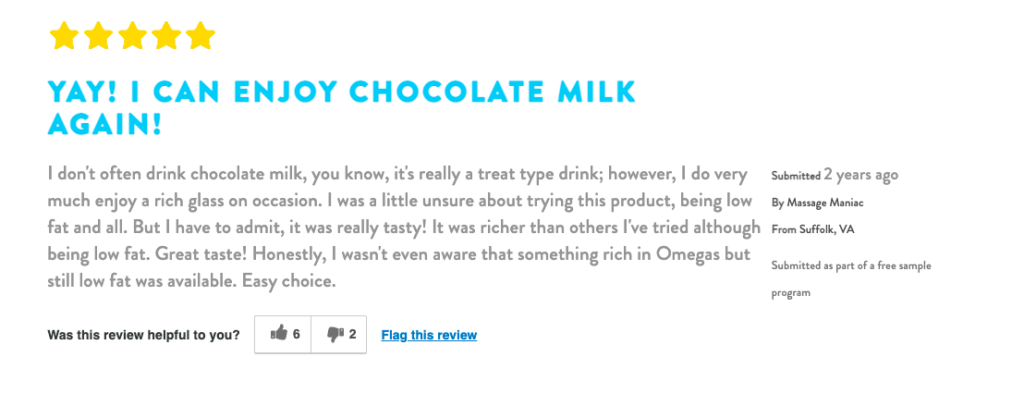
It doesn’t have to be long or complicated. Just be sure to convey your appreciation for the shopper’s business and feedback — and use your own unique brand voice to do so.
3. When you get a neutral review.
There are positive reviews that rave about a product, service, location or app. And of course, there are negative reviews. Then, there are those three-star reviews that fall right in the middle.
For example, this consumer wrote a three-star review for sunscreen. She likes the product a lot. But there’s one particular element — the smell — that she could do without.

Consider using a template when responding to neutral reviews like this one. The template can use language thanking the customer for their feedback — and letting them know what you plan to do with their feedback. For example, you might say you’re going to share the feedback with the product development team.
4. When you get a vague negative review.
Sometimes, negative reviews include plenty of details about what went wrong — like this one for a bed frame.

And sometimes, they’re short and vague, like this review for the same bed frame.

Sometimes when a vague review comes through, you’ve got to get more details before you can effectively fix the situation. A review response template can be a great place to start.
5. When you get a negative review from an angry customer.
Usually, consumers who write negative reviews are calm and level-headed. But sometimes, you’ll get a bad review from a rude, angry or irate customer. Here’s an example of an angry one-star review for a medical office.
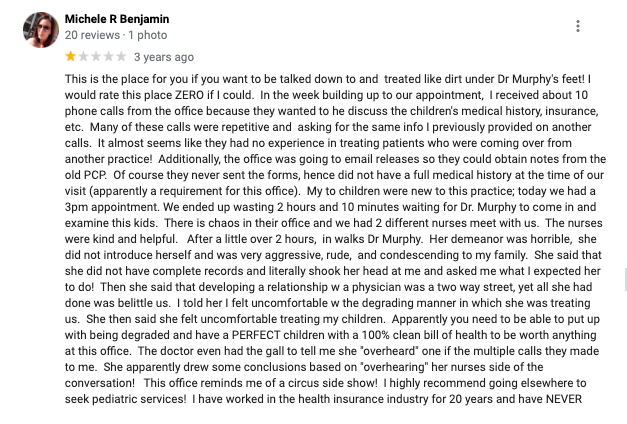
It can be tempting to get defensive — especially when the claims in the review aren’t even true. But an angry response will only make the situation worse — and turn off future customers. So be sure to remain calm and professional.
Angry reviews are a great use case for review response templates because using a template can help you keep your cool. In the template, offer to take the conversation offline so you can come up with a solution that makes both parties happy.
6. When you get a negative review that mentions a damaged or defective product.
No matter how thorough your quality control processes are, there will be instances when a customer receives a damaged or defective product. And sometimes, they’ll share this feedback in a negative review, like this one-star review for potato chips.

Of course, it’s important to respond to these reviews to make things right — and restore the customer’s trust. And a review response template can be a great place to start. Your template should make it clear that you stand by your products — and you’re committing to resolving the issue raised in the review.
7. When You Get a Negative Review About a Store Location
Customers can have negative experiences at even the most well-run store locations. Maybe the store was messy. Maybe they were concerned for their health and safety because of lax COVID policies. Or perhaps, like in this example, a customer had a bad experience with a store associate.
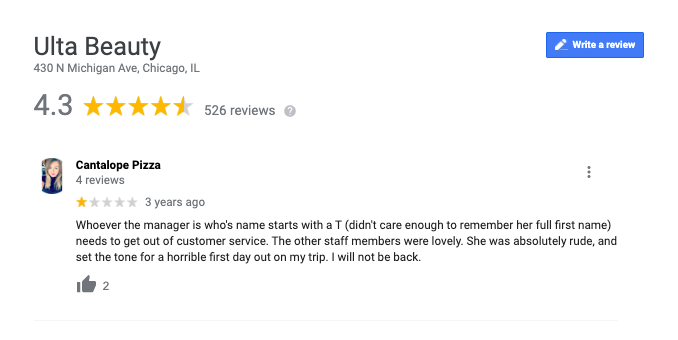
If your store receives a string of negative reviews, it can be enough to keep potential customers away. So it’s important to respond when a negative location review comes through. A review response template can be a great place to start.
Your template should include an apology for the shopper’s poor experience — as well as an invitation to reach out directly to your brand to share more information about their negative experience.
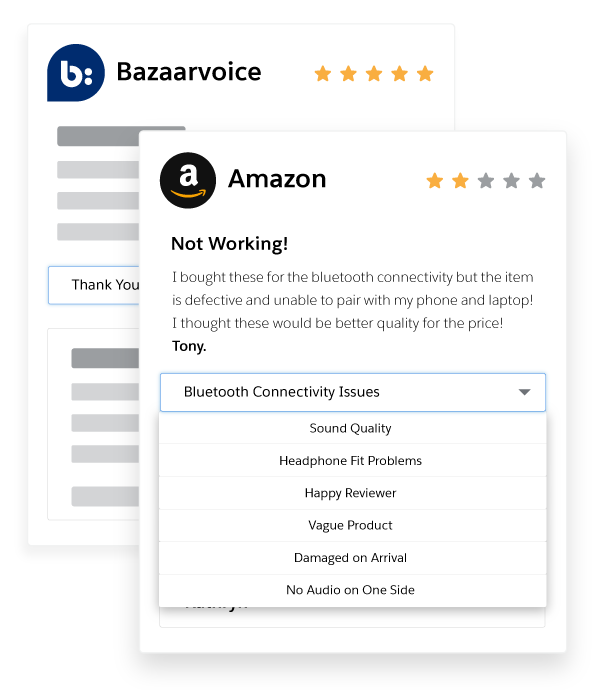 Start Leveraging Templates from Reputation Studio to Make it Easier to Respond to Reviews
Start Leveraging Templates from Reputation Studio to Make it Easier to Respond to Reviews
Responding to reviews is an important way to regain the trust of disgruntled customers — and foster loyalty with happy ones. Review response templates can be a great place to start. With Reputation Studio from 1440, brands can create templates for different types of reviews they see often — and then save those templates within the platform so customer service agents can easily access and use them.
Just remember: templates are a starting place; they’re not meant to be copied and pasted. Be sure to customize each template to the specific review so your response comes across as authentic!